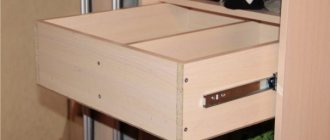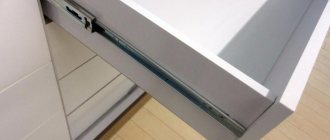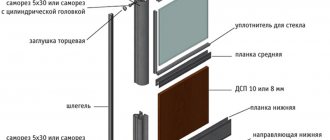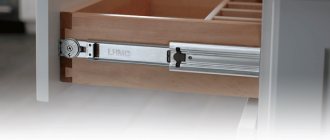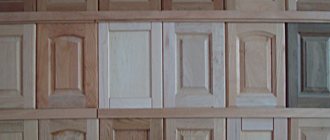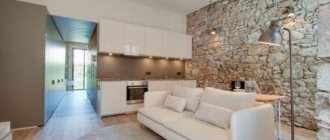Installing a cabinet is not an easy task, especially when you don’t know how and where to install some of the components for this piece of furniture. Auxiliary parts can be, for example, ball guides for drawers. Not everyone knows how to install them, but in the meantime, without them it will not be possible to create a full-fledged place for storing clothes and any other accessories. In this material we will talk in detail about what parts the ball guide mechanism consists of, and how to install these components in the place intended for them.
Ball guides for drawers: how to install
Ball guide design: highlights
So, in order to understand the operating principle of the components we install, it is necessary to turn to their most simplified version - two-section non-separable guides. These parts consist of two rails, which:
- vary in size;
- have the shape of the letter “P”;
- are located one inside the other.
The operation of this element of the system, which is responsible for drawing out the drawers, is carried out due to the mutual movement of tracks made of steel relative to each other, which, in fact, make up the part that interests us. They are also called telescopic because of the way they fold.
Installing ball guides for drawers does not take much time
Between these tracks, as a rule, in the upper and lower parts, there are small balls. They are similar to the same balls that are usually placed in a bearing.
The element responsible for maintaining the structure as a single whole is the outer rail segment. It plays the role of a limiter, preventing the device from moving the drawer further and damaging the weight of the piece of furniture.
Dismantling sequence
Before you remove the drawer from the slides, note that each drawer has two of these features. You must act in the following sequence:
- Pull the drawer out as far as possible.
- Plastic fasteners will be visible in the window. Lower the special “tendril” down and then pull it towards you so that it comes out.
Before removing the drawer from the guides, please note that the arrangement of the antennae varies depending on the design: symmetrical or mirrored.
In the first option, lightly pull both elements down; in the second case, one “tendril” moves down, the other moves up. Determining which method is suitable in your case can only be done by trial and error.
3. Lowering the “antennae”, pull out the drawer. It comes out of the guides without much effort.
Existing types of ball guides
The system we are considering today, which comes as a component for home furniture, can take various forms. So, they will vary due to the original purpose of this motor system, and the set of functions with which it was originally endowed. In the table below, let's study what ball guides can be and by what criteria they are distinguished.
There are many types of ball guides
Table 1. Types of ball guides
| Criterion | Description of species |
| Possibility to disassemble the device | According to this criterion we can distinguish:
|
| Number of "steps" | Based on this parameter, we can divide existing types of guides of the type we are interested in into:
|
| Construction type | According to the item you are looking for, ball guides can be distinguished:
|
| Device installation method | Installation of the parts we are interested in can be carried out in two ways:
|
A box with such guides moves almost silently and can withstand considerable weight
The final cost of mechanisms that cannot be disassembled after installation without losing functionality will be much less than the same value for dismountable mechanisms. The fact is that the latter are produced using sophisticated technology, and are ultimately equipped with specially reinforced balls, which allow the device to be disassembled and reassembled several times without damage or fear of losing small structural elements.
The balls inside the device are made of steel. They move along the internal space of the metal profile, allowing you to easily pull out drawers made of absolutely any material and of any size from a closet, chest of drawers, beds and other pieces of furniture.
These guides are suitable for installation on drawers made of almost any material.
The final cost of these propulsion systems will be influenced by any of the parameters listed above in the table, not just the possibility of disassembly. So, the more pure stages and the number of levels with which the desired system is equipped, the more expensive it will become. This is due, of course, to the difficulties that the manufacturer had to go through when creating the device we are interested in.
Prices for the model range of roller guides
Roller guides
Types of drawer guides and methods for installing them
The guides are represented by a special mechanism consisting of two main parts, one of which is attached to the drawer, and the other to the side wall of the furniture. Limiters and locking parts made of metal or plastic can act as auxiliary elements. Depending on the type of movement of the two plates, ball and roller guides are distinguished.
Ball guides are more technologically advanced, high quality and durable
Among the new hardware for drawers, one can highlight metaboxes and tandemboxes, which are represented by ready-made structures with metal walls with built-in ball or roller guides.
The runners, depending on the type of guides, can be attached to the bottom edge, top or central part of the side of the drawer. The first option is the simplest. It is used for roller mechanisms that are fixed near the very bottom of the box. This method is also typical for tandem boxes, which are mounted in the lower level of the box.
Ball runners for drawers can be installed anywhere on the side of this element. However, their central position is considered the best option, which greatly simplifies installation and subsequent adjustment of the system. Metaboxes are attached exclusively to the top level.
The role of ball guides in furniture production
Despite the fact that the principle of operation of telescopic devices is used to create many products in various fields of scientific and practical human activity, they most often continue to be used in the production of cabinet furniture of various types.
Ball guides are needed to equip furniture with them, which then becomes much more functional, and in addition:
- allows drawers to slide out silently;
- increases the permissible load, which has a direct impact on the box, extending its service life.
Scheme for installing ball guides in a drawer and the box underneath it
So, as an example, we can cite wardrobes, inside of which multiple drawers are installed, saving free space and generally increasing the usability of this piece of furniture. Usually such drawers are filled with clothes and accessories, as they say, to capacity. And yet, thanks to ball guides, they work silently and accurately.
By installing ball-type guides into your piece of furniture, you will increase the service life of the furnishings equipped with them, as well as increase the convenience and efficiency of using the furniture.
Specific installation calculations will depend on the parameters of the box and fasteners selected for it
Installation of roller guides for drawers
- Installation should begin by attaching two guides to the bottom of the drawer. At this time, the roller is located at the back wall of the drawer, the second end of the strip should rest against the front.
Boxes on which the guides will be installed.
Attaching the guide to the side surface of the drawer. - The plank is attached to the bottom of the box with self-tapping screws; it should not be attached to the sides, because the second roller moves along the side. You should pay attention to the screw caps. They should be below the surface of the bar so as not to interfere with the movement of the box.
Drawer with installed guides.
Marking guides on the walls of the facade. - It is necessary to attach the second pair of guides to the furniture body by making preliminary marks with a pencil. When the location for the guide is marked, it is applied to the mark and secured using self-tapping screws.
We repeat this manipulation for all three pairs of guides.
Assembling the box with installed guides.
We install the drawers themselves inside the box and get a finished piece of furniture.
Ball guides for drawers: selection of parts
The set of components we are interested in consists of:
- left telescopic skid;
- right telescopic skid.
Each of the mentioned runners is also divided into two component segments.
Please note: do not assume that ball bearings can only be installed on commercially manufactured furniture. No, in fact, they can be installed on furniture made by yourself, but you will first need to find out its parameters and purchase suitable parts according to them. The fact is that the guides differ from each other in many different parameters, among which thickness is of particular importance.
Each component parameter must be selected by carefully measuring the piece of furniture being assembled
The depth of the box on which the installation will be carried out must be equal to the length of the part we select, however, we must take into account that between the back wall of the piece of furniture being equipped and the back wall of the box on which the guides are placed, it is necessary to leave a minimum gap of 1 centimeter
Also, when selecting guides, it is necessary to take into account the thickness:
- the retractable mechanism itself;
- the outer walls of our box.
In addition, do not forget about adding a technological gap that compensates for the inaccuracies you made when measuring. Using this gap will subsequently provide the drawers with completely free movement. Most often, the value of this technological parameter is approximately a millimeter.
Adjustment of drawers using this type of guides is carried out in two planes
The width of the drawer is calculated by subtracting the following double values:
- thickness of the outer part of the walls;
- the thickness of the mechanism itself;
- the size of the gap left.
The same parameter as the length of the box will be limited by the free space at our disposal. However, it is much easier to calculate it, because all you need to do is reduce the free space by the size of the next gap.
In order to carry out the measurements we need, we will first have to install the drawer in the cabinet box according to all the rules, and then we will be able to adjust it, make the markings correctly, and subsequently properly hang the guides.
Telescopic guides for drawers are modern fittings that allow you to effortlessly open even massive structures. Would you like to learn in detail about the installation of telescopic guides and the correct calculation for their installation? Read the special article.
Video - Ball guides. Installation
Retractable mechanisms for drawers, types and subtypes
Wooden and plastic “sleds” are already a thing of the past. Some difficulties are experienced by those who decide to restore or repair an old chest of drawers or sideboard with their own hands. It will be extremely difficult for them to select any drawer system for drawers on such runners, without adjusting the necessary gaps to be able to install modern mechanisms.
It’s better to leave everything as is, clean and re-glue the broken parts of the chest of drawers. All other methods will be associated with labor-intensive and financially expensive alterations of both the drawers themselves and the inside of the furniture with your own hands - as a rule, in such furnishings it is not monolithic, but assembled on the basis of a frame.
With the help of linings, the attachment points of the selected guides are “formed”. And then, after measuring the resulting openings for installing the drawer, new boxes of drawers are ordered in size. That is, in fact, after such a repair, only the front part of the old chest of drawers remains. And inside he moves completely.
The main types of modern retractable mechanisms for drawers
In order of increasing cost and quality of guides, all offered sliding mechanisms for drawers can be divided into two main types and four varieties:
- Roller and ball guides.
- Metaboxes and tandemboxes.
Visually distinguishing them is not difficult. To install the first two, you need a separate box box, with all the sides made of laminated chipboard and the bottom made of fiberboard. The sides of the second type of drawers, metaboxes and tandemboxes, are metal; they are actually part of the retractable system.
To install such retractable systems with metal sides, it is necessary to “assemble” the drawer box from the back wall and the bottom from laminated chipboard. The dimensions of the parts are calculated according to the formulas of the specific selected system.
We will consider the remaining fundamental differences separately.
Roller and ball guides, comparison
The “evolution” of wooden and plastic runners began with the simplest roller mechanisms and came to ball retraction systems.
The advantages of roller guides for drawers include relatively low cost, easy movement, ease of removing the drawer from the body, and easy installation with your own hands according to the marking diagram.
True, the markings should be done as accurately as possible, down to the millimeter, since the ability to adjust the drawer stroke and install the facade is very limited.
Also among the disadvantages should be noted the fragility of the roller guides and noisy operation. The wheels, thanks to which the box moves along the slides, although “wrapped” in a rubberized shell, do not ensure silent movement. When the box is heavily loaded or there is any distortion in the box, they begin to creak and fall out of the grooves.
Ball guides for drawers are silent and can withstand much larger loads. And much more durable.
In addition, the range of ball guides is much more diverse: they can be full or partial extension, with different load-bearing capacities, equipped with closers, etc. But they also cost more than roller ones.
Retractable metabox system
Metaboxes (metalboxes) are a retractable mechanism with single-walled drawer sides and guides on rollers. From the point of view of “evolution”, metaboxes can be called a “branch” of the development of roller guides.
The range of metaboxes allows you to choose between full and partial extension drawers, with a load capacity of up to 25-30 kg, with soft-closing closers and the ability to expand the side walls using special elements - rails and perforated walls.
Rails can be attached both along the drawer guides and across them using special fasteners. They form an additional system of divisions for fixed storage of any items inside the box.
Such accessories are not suitable for all metaboxes! Consider the series of specific manufacturers and the range of accessories offered for the series. The photo shows the metabox blum series. It also has the ability to install closers, various blockers and locks.
Bloom metabox extension systems are characterized by minimal sagging, high stability and excellent gliding throughout their entire service life.
The size range of metal boxes allows you to choose length guides for boxes with a depth of 250-750 mm from different manufacturers. And the height of the side is 54, 86, 118 or 150 mm (with the possibility of extension with additional elements).
Retractable tandembox system
Tandemboxes are a “collective” term for all double-walled extension systems, inside of which a more advanced ball mechanism with an additional “upgrade” is hidden, providing greater load capacity and smoother operation.
Each manufacturer has its own series of “tandem boxes” with double metal sides of the boxes. For example, Tandembox from Blum, Innotech from Hettich, Swimbox from Boyard, Delinia from Leroy Merlin.
Each series has certain quality characteristics and the ability to expand functionality with various elements in the form of inserts, dividers and roof rails.
Additional design of the drawer can expand not only the functionality of storage, but also be one of the components of the interior design.
How to install ball guides on drawers with your own hands
So, we have come to the moment for which, in fact, you were looking for this article. It involves learning how to independently install ball guides on drawers for a cabinet or other piece of furniture. So let's get started.
Drawer on ball guides
Step No. 1 – make markings for fittings
So, first of all, you need to make markings for the fittings being installed. It is done using a pencil and a ruler, since we need to mark the axis passing strictly through the central part of the box.
First of all, we need to draw an axis under the guide
After this stage is completed, we move on to the next one.
Step No. 2 – Attach the component runner to the marked side of the drawers
So, we have drawn the axis along which the parts will be installed. Now you need to place a guide rail on it so that the front edge of this part is flush with the façade of the furniture segment being equipped. However, you need to carefully ensure that the part does not bulge forward, since in this situation it is quite possible that a gap will appear, which we do not need at all.
Pay attention to the runner. The regulating holes cut on it will help us place it correctly. They are small and oblong.
The required adjustment holes are needed in order to correctly secure the runner relative to the box
Using the discovered holes, we align our runner strictly along the marked axis. This is easy to do: just line up all the holes with a line so that it clearly runs through their center.
Then we insert a self-tapping screw into the hole located horizontally on our part. Now we can move the runner back and forth without changing the position of its segment.
Adjustment hole responsible for the direction of movement up and down on the back of the drawer
We secure the rear segment of our runner through the gap responsible for the movement of the box along the vertical axes. This will be necessary in order to subsequently be able to adjust the height of the box by following the next few simple steps.
- Using a screwdriver or screwdriver, remove the self-tapping screw from the front hole, which is responsible for the horizontal movement of the box.
- We will re-screw the same self-tapping screw, however, into the front hole, which is responsible for the movement of the box along the vertical axis.
Duplicate adjustment hole for the “up and down” direction, for the front segment of the cabinet part being equipped
Then we will get that the part will subsequently be attached to the box through two control holes located both in the front and in the back of the box, which are responsible for its movement along the “up and down” axis.
Step No. 3 - installing the guide directly to the side of the box
Now, in order for our device to work and the drawers to slide out, it is necessary to attach the second part of our guide system to the inside of the cabinet box, inside which the drawer is then installed.
The mounting hole, inside of which a self-tapping screw is placed, is of the most common type, round
Prices for cordless screwdrivers
Cordless screwdriver
Only here you need to take into account one important point: unlike the segment of the guide system that attaches to the side of our drawer, the part that goes into the box has much more adjustable holes. And in addition to the gaps through which the system can move along the axes of interest to us “up and down” and “forward and backward,” they also have other grooves of the horizontal and vertical type, into which screws also need to be screwed.
Mounting hole and adjustment grooves, the presence of which must be taken into account when installing this part of the guides
Attach the guide and adjust it, thus inserting screws as in the previous step into only two holes so that the box fits inside the correct box. Once you are sure that everything is installed and adjusted as intended, remove the boxes again and screw the screws into all the holes of the box parts.
General criteria for choosing guides and drawer mechanisms for drawers
All systems of retractable guides for cabinet furniture are support rails with symmetrical fastening to the inner sides of the cabinet sides. Their main function is to ensure the movement of retractable furniture elements (drawers, shelves, baskets, etc.).
Load bearing capacity
The first criterion for choosing drawer guides is load capacity. Thanks to the high-tech developments of individual furniture market leaders, modern drawer mechanisms can withstand loads of up to 60-70 kg. However, for a simple chest of drawers for storing clothes, shoes and other wardrobe items, such a carrying capacity is not needed; you can limit yourself to a choice of 10-20 kg. For large lower kitchen drawers, pull-out systems with a load-bearing capacity of 30-50 kg are usually selected; they can store heavy pots, pans and other kitchen utensils.
Extension system: full and partial extension, hidden installation
The second selection criterion is the type of drawer system.
There are full extension and partial extension drawers (approximately 70-80% of the cabinet body). The former are, of course, much more convenient, but also cost several times more. Such an investment is justified if you plan to store something large in the drawer that does not change its volume. For example, square containers for bulk products, tall pots or household appliances in boxes. For linen and “office” drawers, the use of full drawer systems is not important.
Separately, it is worth highlighting systems for sliding drawers of hidden installation, when the sliding mechanism is installed in the bottom area, and not on the sides of the drawer.
For the most part, they are not of any practical nature, there are only visual differences - a box with “smooth” sides, without guides, looks more aesthetically pleasing. As a rule, retractable mechanisms for hidden-mounted drawers are designed for a large load capacity, which is understandable due to the nuances of installation.
Guide length
To maximize the use of a cabinet or cabinet for storage, drawer guides should be selected according to the depth of the sidewalls. Most manufacturers offer retractable systems in 50mm increments, ranging from 250mm to 500, 550 or 600mm. It is very rare to find guide lengths of 650, 700 or 750 mm on sale.
For example, in a cabinet with a side depth of 400 mm, a drawer with a guide length of 350 mm is designed.
And, conversely, if you plan to install drawers, baskets or cargo with a depth of 500mm in a kitchen cabinet, you should design a box for “them” with a depth of 520-550mm.
About the width of drawers
From the point of view of ergonomics and ease of use, the optimal width of a drawer is about 400-900mm. If you want to make a longer drawer, for example, in the design of an elongated TV stand, then you should immediately discuss the nuances of its operation. It should be loaded with things evenly, otherwise it will inevitably warp. And the guides will quickly fail.
By the way, the TIP-ON retractable system, which opens the drawer when pressed, has a synchronizer that ensures uniform opening. It is designed specifically for long-width drawers.
“Push” mechanism for drawing out the drawer: opening by pressing
Blum's aforementioned Tip-on pull-out mechanism offers push-to-open operation for handle-less cabinet designs.
Hettich has a similar opening and sliding system called Push to Open. You can read about other possibilities for opening drawers using a push mechanism in the article “Pushers for facades.”
This category also includes opening systems operating on an electric drive. True, you will need to press not the facade, but the electric drive button.
Pull-out mechanisms for drawers with closers
The presence of a damping system on the facades and drawers of the kitchen, children's room, and any other cabinet furniture significantly increases the service life of the opening and closing mechanisms. Not to mention a qualitatively different level of comfort during use - “silent” furniture is much more pleasant to use.
In most tandem boxes, a soft closing mechanism, “pulling” the box into the closed state, is built in by default. When choosing one option or another, pay attention to the presence of this characteristic.
The closer can be built into the ball guides right away, as you can see in the photo.
But the design of the roller guides does not allow the possibility of integrating a soft closing mechanism. For metaboxes, you can purchase a closer capsule separately; you can read about how to select and install closers on a drawer here.
I also recommend reading about the principles of fastening the drawer drawer mechanism, the installation method using the example of installing ball guides. Perhaps this information will be useful to you when choosing a particular type of guides or pull-out mechanism for drawers.
